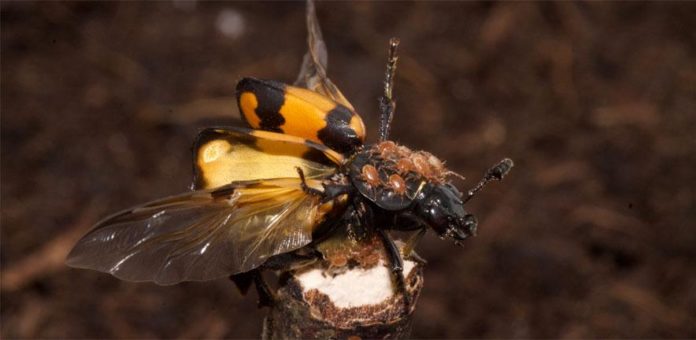Social interactions within species and mutualism between species are both well characterized, but their influence on each other is poorly understood. In a new study by the University of Cambridge, scientists determined how interactions among burying beetles Nicrophorus vespilloides influence the value of their interactions with the mite Poecilochirus carabi.
Scientists found that beetles who consistently lose out to members of their own species have the most to gain by forming a mutually beneficial cross-species partnership.
Scientists examined the relationship between the burying beetle and the tiny mites that hitch a ride on their backs. The specialists found that mites work like a comfortable coat on smaller beetles and cause them to warm up when the beetles exercise. This made them increasingly effective in face-offs with larger opponents.
For bigger beetles, the mites really diminished their level of fitness. They required no assistance from mites to win ownership for a dead body and after that missed out in light of the fact that the beetle larvae needed to contend with mites for food.
Relationships between two species where both advantage –, for example, blooming plants pollinated by insects – is known as mutualism. These connections are across the board and are critical to keeping up biodiversity and biological community work, however, they are highly variable.
Syuan-Jyun Sun, a Ph.D. candidate in Cambridge’s Department of Zoology and the paper’s first author said, “When the costs of a mutualistic relationship start to outweigh the benefits, it will break down. We wanted to find out if competition within species might be one of the reasons why we see such variety in mutualistic relationships.”
Scientists wanted to test whether ‘losers’ might be more likely to have a mutualistic relationship with another species in order to gain an advantage over their stronger rivals. At the same time, ‘winners’ may not need any help to win battles, so a mutualistic relationship wouldn’t bring any advantage and might even break down into a form of parasitism.
They tested this idea with experiments on burying beetles and their mites. The mites Poecilochirus carabi are benign passengers on their host burying beetles Nicrophorus vespilloides. The beetle flies around, seeking out the bodies of freshly dead small animals like mice and birds. Both the beetle and the mites onboard use the dead body as food for their young.
However, beetles face fierce competition for the ownership of a carcass, such as a dead mouse, and smaller beetles often lose the territory to larger rivals. Since the beetles need the carcass to breed, how do smaller beetles manage to reproduce?
Sun said, “We wondered whether mites could give these ‘losers’ a helping hand in fights over a carcass. In the lab of Professor Rebecca Kilner in Cambridge, the researchers staged contests over a dead mouse between two beetles that were matched in size. One carried mites, while the other did not. They filmed the fights with infrared thermography, and found that beetles with mites were hotter and more aggressive, and therefore more likely to win.”
To explore how such warm advantages emerged, the scientists built a ‘gym’ for beetles and practiced them on custom treadmills. Beetles either conveyed mites or a weight that was equal to the mites or they don’t convey anything.
Sun said, “We found that carrying extra weight caused beetles to generate extra heat as they exercised. We also discovered that this heat was trapped by the mites because the mites form an insulating layer when traveling on beetles.”
These effects were most pronounced for smaller beetles because mites covered a relatively larger surface area than on large beetles, suggesting that mites are likely to be disproportionally beneficial to smaller beetles.
To test this idea directly, the researchers again staged fights between two beetles over a dead mouse. This time, the two rivals differed in body size. They also let beetles lay their eggs on a mouse, with and without mites.
The researchers found that small beetles were much more likely to win a fight for a carcass when they were carrying mites. However, the mites slightly reduced the beetles’ reproductive success, because they competed with beetle larvae for carrion. Nevertheless, the huge benefits of acquiring a carcass for reproduction outweighed these small costs. For smaller ‘loser’ beetles, mites are mutualist because they increase beetle fitness.
The findings were different for larger beetles. They needed no help to win a carcass, so they gained nothing from associating with mites. To make matters worse, they then lost fitness to the mites when they bred alongside each together on the carcass. For larger ‘winner’ beetles, mites are antagonistic rather than mutualistic because they reduce beetle fitness.
The results are reported in the journal Evolution Letters.
